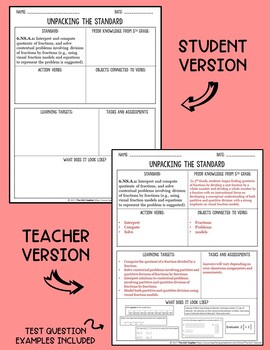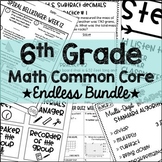Unpacking the Standard - Number Systems
- PDF
Also included in
- This GROWING BUNDLE is a perfect solution for the busy 6th grade math teacher! This bundle includes notes, quizzes, tests, spiral bellringers, classroom decor, and activities directly aligned to the 6th Grade Math Common Core State Standards. You will also receive items that ARE NOT in my store thatPrice $112.00Original Price $196.00Save $84.00
- This will soon include ALL 6th Grade math standards. Buy it now to the get the lowest price!Have you ever looked at a standard and wondered, “What is this? How am I going to teach it?” Have you ever had a student say, "What do all of these words mean in this standard? I don't know what its saying."?Price $5.00Original Price $6.00Save $1.00
Description
Have you ever looked at a standard and wondered, “What is this? How am I going to teach it?” Have you ever had a student say, "What do all of these words mean in this standard? I don't know what its saying."? If so, this resource is for you!
The work of learning and implementing new standards has to happen quickly. Implementing standards effectively requires teachers and students to dive deep into the standards to fully understand expectations and goals.
Instead of saving the unpacking just for the teacher. This resource allows you to unpack the standard with your students! This allows them to dive deep into the standard and better understand what is expected.
What is included?
For each Standard: Standard, Prior Knowledge, Action Verbs. Object connected to actions, Learning Targets, Tasks and Assessments, What does it Look Like (Example Test Questions included)
Standards included:
6.NS.A.1
6.NS.B.2
6.NS.B.3
6.NS.B.4
6.NS.C.5
6.NS.C.6
6.NS.C.7
6.NS.C.8
Answer key for guidance included
*** When printing, make sure to click on "Shrink Over sized Pages" so that it will print correctly.
Do you want to see how these look in the classroom?
Click the link below for my Instagram account!
● ● ● ● ● ● ● ● ● ● ● ● ● ● ● ● ● ● ● ● ● ● ● ● ● ● ● ● ● ● ● ● ● ● ● ● ● ● ● ● ● ● ● ● ● ● ● ● ● ●
Customer Tips:
How to get TPT credit for future purchases:
Go to your "My Purchases" page. Next to each purchase. You'll see a "Provide Feedback" button. Simply click it and you will be taken to a page where you can give a quick rating and leave a short comment for the product. Each time you give feedback, TPT gives you feedback credits that you may use to lower the cost of your future purchases. I would be VERY grateful for your feedback. Feedback is so VERY important.





